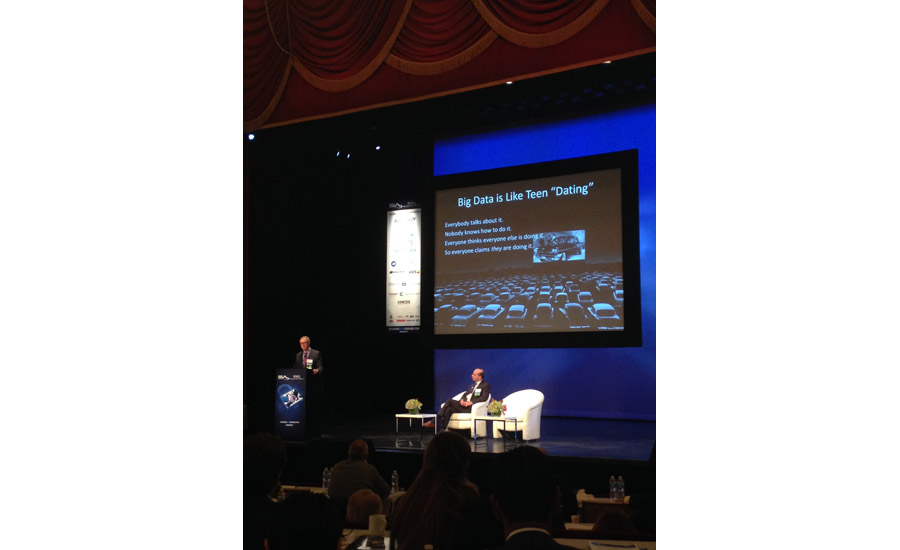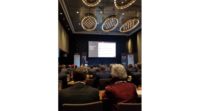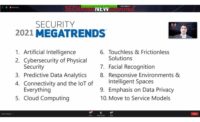At Securing New Ground, a Security Industry Association (SIA) executive conference held October 28 and 29 in New York City, all the buzz was about what the next big trends will be for the security industry. This year’s conference was the 20th annual gathering of industrial professionals, including buyers, dealers/integrators and manufacturers who meet to share perspectives on megatrends, disruptive technologies, new entrants to the marketplace and potential threats.
SNG conference speakers and participants this year highlighted again and again one major issue facing virtually every aspect of the industry — cyber security. In fact, SIA dedicated a half day forum track on day two to “Cyber Security for Physical Security Pros,” which was designed to “provide a plain English translation of IT security concepts and actions so any physical security leader can effectively engage in a discussion of cybersecurity.” For that track SIA partnered with the Global Security Risk Management Alliance, which was formed last April to help lead the security risk discussion.
“With cameras and other pieces of security equipment all online, raising awareness of cybersecurity is one of the top priorities identified by the SIA board,” said SIA Chairman of the Board V. John Stroia in his welcoming remarks. “SIA recently announced to its membership a new cybersecurity panel, which will advise members about emerging cyber threats and trends.”
Stroia also pointed out the creation of the Internet of Things working group and the expanded reach of the OSDP, which allows peripheral devices like readers to interface with control panels, as two other major SIA priorities. For the first time this year SIA teamed with The Freedonia Group to produce research on physical electronic security products. The report found the market for security products is projected to rise 7 percent annually through 2019 to $16.2 billion. According the executive summary provided to attendees, “Rising interest in networked, IP connected systems that provide interoperability between various electronic security systems and building automation systems will continue to promote growth of higher value devices.”
Indeed, many of the top technology megatrends mentioned in several of the sessions were all variations of that finding.
Industry Movers
In one of the first sessions, “Megatrends: Creating Big Challenges and Greater Opportunities,” Steve Van Till, president and CEO of Brivo Systems, spoke to the gathering about the top four megatrends: cloud, big data, Internet of Things (IoT) and mobility.
“I had hoped not to be talking about cloud today but it just won’t go away,” he said. “You can’t not talk about the cloud. It is foundational. We are just about to hit a growth wave around that.”
In fact, in a joint session with The Freedonia Group, industry research firm IHS also presented findings from a recent report that supports this. “Hosted/managed access control is a small but growing focus going forward as integrators look to add RMR revenue, said Blake Kozak, principal analyst, security and building technologies for IHS. By 2019 52 percent of doors will fall within the one to 40 door category, which is the “sweet spot” for hosted/managed access. “That is an incredible amount of opportunity,” Kozak added.
A new feature SIA added to SNG this year was an interactive audience response by instant poll. One question asked the audience which technologies will be most disruptive. Mobile identities and hosted/managed were the top responses.
Speaking at a session looking specifically at the access control/identity management market, Denis Hebert, chairman-elect of SIA, called mobile a paradigm shift. “It is going to represent a change. I don’t think the card goes away because there are a number of circumstances where visual ID is important. But cards will be a complement of the mobile business. Now mobile is the complement, but that will likely reverse over time because of the convenience and opportunities of the mobile device.”
Hebert also predicted the adoption of mobile will happen in half the time it took for smart card technology to gain wide acceptance. “I think the mobile curve will probably be shorter because of convenience, but it will take a period of time.”
In his presentation, Van Till also cited mobility as a top trend, particularly for its ability to provide “situational awareness,” which he said is the first rung on the IoT ladder.
“The Internet of Things is the second big megatrend,” he said. “It is pretty close to the top of the hype cycle right now, to some extent getting a bad rap. There are a lot of frivolous things that make the news. But it turns out that the home or consumer market is the smallest category of the IoT economy.” Together government and enterprise make up more than three quarters of the potential IoT market, he said. “GE predicts the industrial Internet of Things will add trillions to the economy. Anything that big can’t help but have an effect on what we are going to do.
“The number of IoT devices will be greater than smartphones, computers or tablets. Many of these will be small sensors and devices. Why does this matter for security? Is there a job that these devices can do for us? Yes. They can provide more data, more control, business process improvement, local or artificial intelligence.”
ASSA ABLOY Americas president and CEO, Thanasis Molokotos, also spoke of the IoT, particularly where it intersects with wireless technology. “Wireless has been a big game changer for us and the IoT is riding on the back of wireless technology. In five years we should expect we will be cutting the cord across the board, for power as well as data. That means we will have slashed installation costs and achieved a deeper penetration inside the building with more than 25 percent of doors. Today that number is under 5 percent.”
That is a critical precursor to the IoT, he forecast. “This will be the era of truly connected buildings. The explosion of connected devices is mind boggling and all of these new technologies are driving smart devices that are starting to talk to each other in a more seamless way. In five years no building will be left behind. All buildings will be smart.”
Which will lead to the other big trend discussed at SNG: big data.
Van Till humorously compared big data today to teen dating. “Everybody talks about it. Nobody knows how to do it. Everybody thinks everybody else is doing it. And everyone claims they are doing it.”
Kozak noted that less than 5 percent of projects today are deploying true “big data” solutions, “not because they don’t understand it or don’t want to do it. The complexity is continuing to be a barrier today. There is still a big question on how to quantify opening and closing doors and turn that into intelligence, or using mobile phones and beacons and wireless capabilities.”
While many of these big picture technologies and trends may be overwhelming, both Van Till and Molokotos had some straightforward advice for integrators.
“The best advice I have seen on big data is start with a pencil,” Van Till said. “You don’t need software or computers to start. Simply write down what you would like to know. The answer to that is norms, patterns, profiling, variance and black swans.”
Molokotos suggested hedging your bets. “Bet on multiple technologies. No one can see the future clearly in terms of which technologies will prevail. We need to participate in several new technologies because being a fast follower doesn’t work well these days. But in a world that is faster and more integrated, never forget that the customer is True North. Stay close to your customer; spend more time with the customer and listen carefully.”
The Gorilla in the Room
Throughout the two-day conference the one topic that seemed to underpin everything was what one panelist referred to as the “800-pound gorilla” in the room. Virtually all the future trends (and many current ones) share a common feature: They all ride on the network backbone. And nearly everyone agreed that there isn’t enough being done to ensure the cybersecurity of the many security technologies that are being put on that network.
“Cyber is the ‘break’ on all the other megatrends,” said Ray Coulombe, founder and managing director for SecuritySpecifiers and moderator of a panel titled “Re-thinking Strategic Priorities: How Megatrends Will Affect Your Business.” Panel participants, who included consultants, cybersecurity experts, manufacturers and integrators, were asked to rank the megatrends in terms of importance. Cybersecurity was the overwhelming top choice, followed by cloud, big data and IoT. When the audience was polled about which megatrend poses the highest risk, cybersecurity came in at around 67 percent. But when a follow-up poll question asked whether cybersecurity is getting the attention it deserves, an overwhelming 81 percent said no.
“As an industry we need to recognize cyber as a threat,” said integrator Dan Moceri, co-founder and executive chairman of Convergint Technologies. “Most of us have it as high priority. We think about it in terms of technology. That is important, but process and people are also important elements. Passwords are critical and not just default passwords. Everyone has a backdoor password and ports that are open on those devices all the time.”
John DeGeorge, principal consultant, JDG Security Management & Consulting, added, “As a practitioner I have concerns about the security of the cloud and yes, there is a real risk. Cyber and cloud and big data are a triumvirate that are all linked together. Most IT divisions have wholeheartedly embraced cloud technology. Old school security directors like complete control, but those days are long gone. Security has to talk to other systems.”
The days of siloed physical and cyber security will have to end, predicted Adam Firestone, president and general manager, Kaspersky Government Security Solutions Inc. (KGSS) in a panel on “Safeguarding Corporate Assets.”
“We need to look at how we perceive as business leaders the nexus between conventional and cyber security. We live in a siloed environment today. The problem is that you wouldn’t separate physical security from business operations now. You integrate door locks, guards, gates and guns, but we still silo cyber because for the last 30 years it was an ‘IT thing.’ So we expect magic to happen from that side and magic can’t happen without integrating those operations.
“Until we discipline ourselves to start looking at an overall business enterprise, our basic level of cyber hygiene — whether personal or corporate — isn’t adequate. You are a target waiting to be exploited. My perception is as an industry and country we are in risk acceptance mode and precious little detection mode. We need to change the policies.”
Fredrik Nilsson, general manager, North America, for Axis Communications suggested that IT departments won’t be content even with a separate security network in the future. “Even if you have a separate network from IT, trust me, they will find that network eventually. In one instance we had more cameras than laptops on the network and IT started to question that.
“Will we converge with cyber security or be a separate track?” he asked the audience. “The answer is today we are already on the same track. The question is do IT folks believe that security has the wherewithal to participate with them?”
The bottom line, according to Christopher Peckham, senior vice president, chief technology officer and special projects, Kratos Public Safety & Security Solutions Inc., is that cybersecurity must be part of the conversation going forward.
“Until recently I am not even sure the risk was discussed,” he said. “Until that risk is recognized and understood by everybody it will be a difficult conversation to have. Cyber is one of the questions that needs to be part of the process. We are putting something on the network and we need to make sure we follow proper procedure and add additional levels of security to make it secure.”
Regarding cybersecurity and all the other megatrends highlighted at the conference, Molokotos left the audience with this piece of sage advice: “Discover new oceans. All these trends make us feel very unsettled, but also provide us with enormous opportunity. You have to be bold, and be willing to venture into unfamiliar territory; because if you don’t, somebody else will.”







